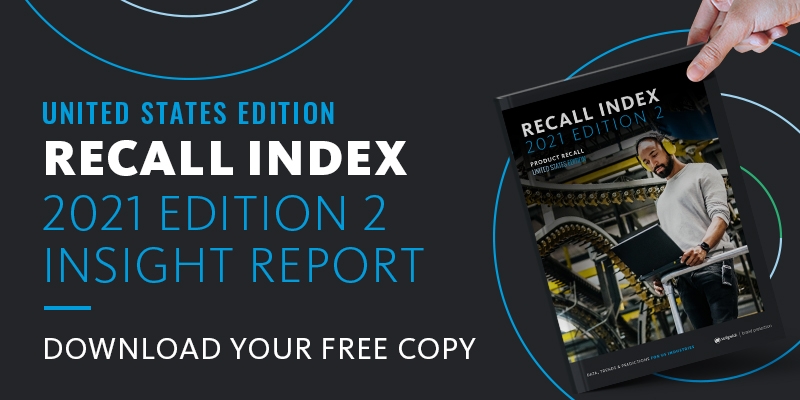As regulators, businesses and organizations emerge from the global pandemic, each is struggling to find its path to a new “new normal.” Most are finding it’s a rocky path. Significant questions and uncertainty persist, and reputational risks to companies across all sectors are at an all-time high as consumer advocates and U.S. lawmakers maintain pressure on regulators to crack down on unsafe products, as reported in the latest edition of our 2021 Recall Index report.
The new report offers the latest recall data, trends, and predictions from the first half of the year, as well as expert analysis and predictions for what to expect for the remainder of 2021 and into 2022. We also feature insight from some of our strategic partners at leading law firms to help you prepare for the increased risks created by product innovations and evolution in the regulation of food, drugs, consumer products, medical devices and automobiles.
Increased risk for automotive industry as technology races full speed ahead
Even as recall activity for the first six months of 2021 trends slightly behind 2020, recall events remain a significant risk. In addition to a growing list of recalls due to faulty airbags and fire-related risks associated with electric vehicles, companies should be thinking about how current business challenges and regulatory developments could lead to future recalls.
The National Highway Traffic Safety Administration’s (NHTSA) investigation into Tesla’s Autopilot system following 11 crashes and 17 serious injuries since 2018 sends a huge signal that the federal government will be aggressively erring on the side of caution regarding vehicles reliant on artificial intelligence. Congress and the U.S. Department of Transportation are joining NHTSA with a renewed focus on regulatory oversight of high-tech cars, trucks and everything that goes into them. Companies will have their work cut out for them as they work to find a new balance in supply, demand, safety and innovation.
Gloves-off approach to oversight and enforcement in stores for the consumer product industry
The U.S. Consumer Product Safety Commission (CPSC) announced 64 recalls in the second quarter of 2021, returning to quarterly averages observed in 2019 and 2020. In our last quarterly index, we said the CPSC’s story will likely be less about recall numbers and more about the agency’s newfound gloves-off approach to oversight and enforcement. And as predicted, changes within the CPSC are coming to fruition. The agency has taken a palpably more aggressive approach to enforcement (demonstrated by a desire for stronger legislation and policies such as mandatory standards), and is benefitting from an increased budget.
Food industry sees heightened security and increased enforcement from the FDA
Food recalls increased 20.5% to 106 events in the second quarter. These recalls impacted 7.9 million units, representing a 232.1% increase quarter-over-quarter. While still trailing 2019’s quarterly average of 125 recalls, this activity appears to signal a possible return to pre-pandemic recall levels – at least in terms of events. Moreover, the industry is seeing heightened scrutiny and regulatory enforcement from the FDA. The agency’s newfound initiatives outlined in its New Era Blueprint have already changed the way the FDA monitors and engages with the food industry, indicating that the agency has big plans. Companies across the entire food industry should be watching Congress, the FDA, the World Health Organization and any resulting media attention to understand the potential regulatory compliance challenges.
Medical device industry is in the midst of a rebound
The medical device industry is hoping the global coronavirus pandemic is beginning to wane, and signs point to the industry being in the midst of a rebound. However, this doesn’t mean that oversight of the industry will return to a pre-pandemic “normal.” Companies can expect some of the changes introduced as a result of the pandemic will be here to stay – hopefully in a way that is beneficial to regulators, manufacturers, healthcare professionals, and patients. In terms of numbers, medical device recalls decreased for the fourth straight quarter to just 173 events, down 18.4% and resulting in a nine-quarter low. Despite the decline in events, impacted units increased 160% to 158 million units, the highest since the first quarter of 2020.
New legislation and regulation on the way for pharmaceutical industry
Pharmaceutical recalls dropped for the third consecutive quarter, decreasing 6.3% to 59 events and marking a new low since the fourth quarter of 2015. Unsurprisingly, failed specifications and quality concerns were the leading causes of second quarter recalls, each accounting for 11 events or 18.6% of events. Additionally, as efforts from the Biden administration to safeguard the industry get underway, and new legislation and regulation slowly find their way to the forefront, companies should be taking steps to double down on some of the most common quality and safety risks, including carcinogens, labeling issues, the influence of independent pharmacies and labs, and the evolving regulatory landscape.
We know consumers may be eager for a return to normal, but the 2019 “business-as-usual” posture for regulators and legislators is a thing of the past. Activists and regulators are poised for action, with the new Biden administration signaling that it will be at the head of their parade. Companies across all industries would be wise to closely re-evaluate all manufacturing processes, vet supply chain partners and invest time and resources to prepare recall management, crisis and communications plans.
To help keep your brand and reputation intact, regardless of the business and regulatory environment, companies must make sure they work with regulators, communicate efficiently, understand the full scope of regulatory exposure, and respect the power of public perception.
Get more recall data, trends and predictions, along with additional insights and commentary from some of our strategic partners in the latest edition of our Recall Index report – available for download here.
